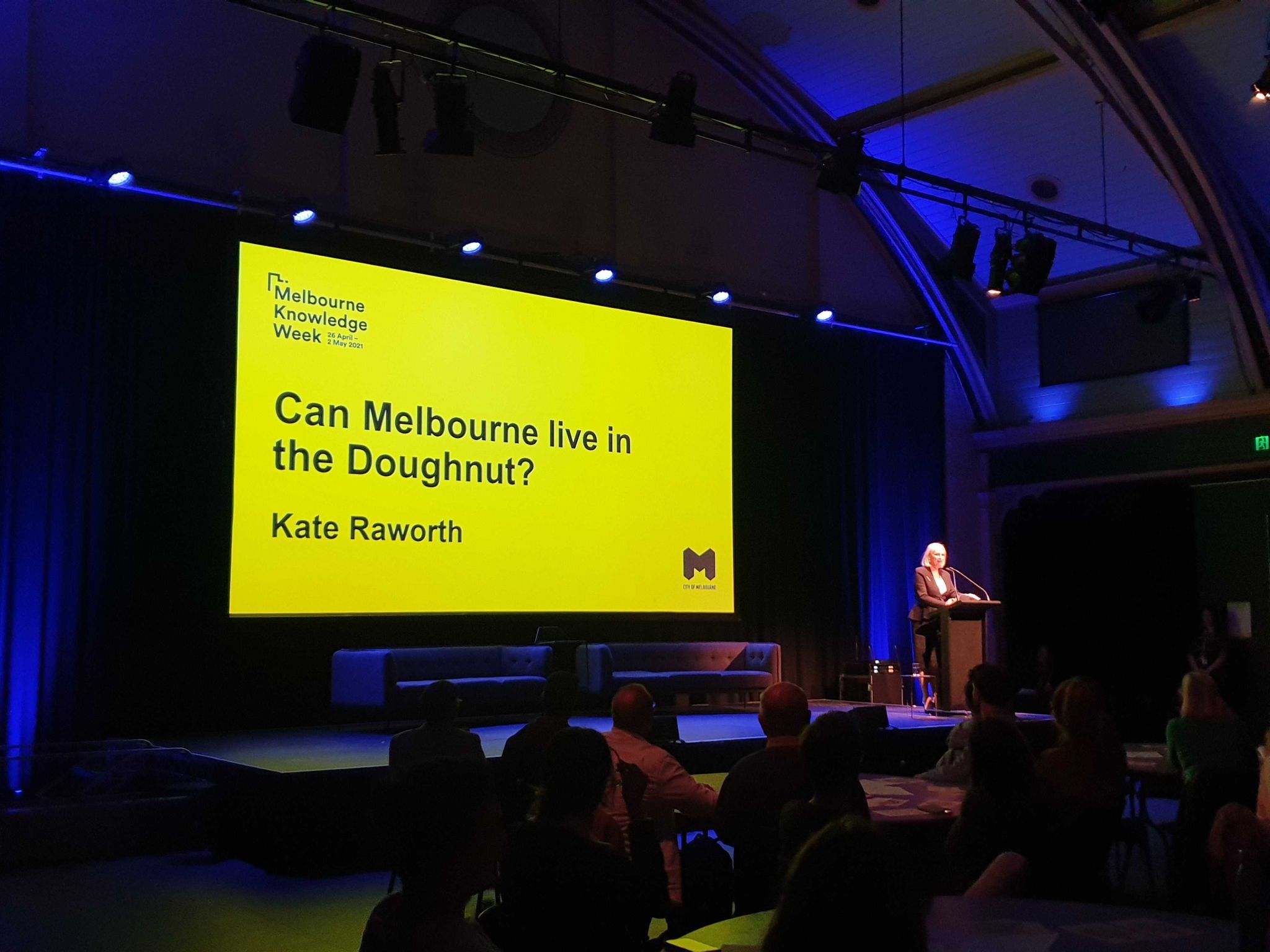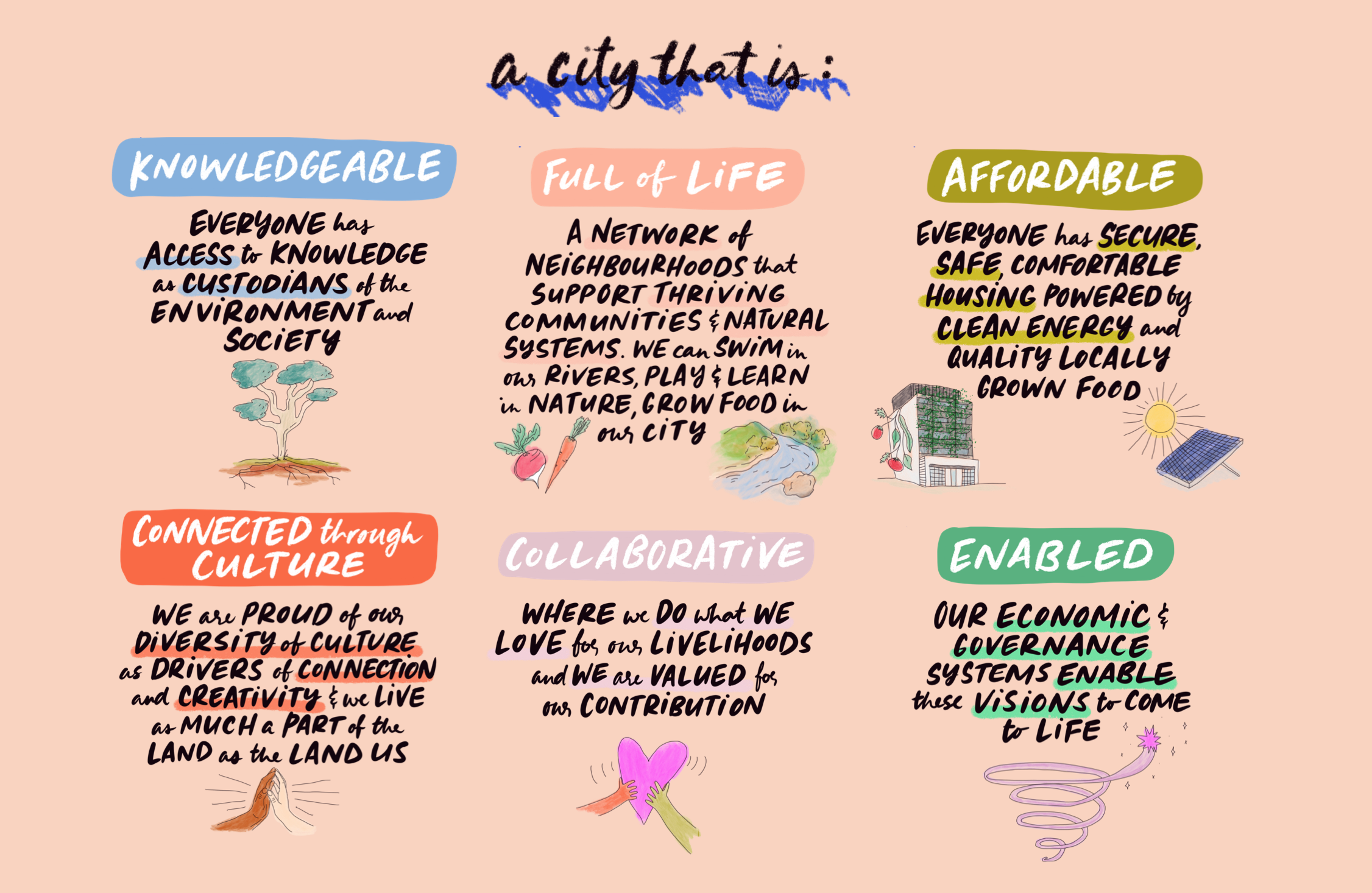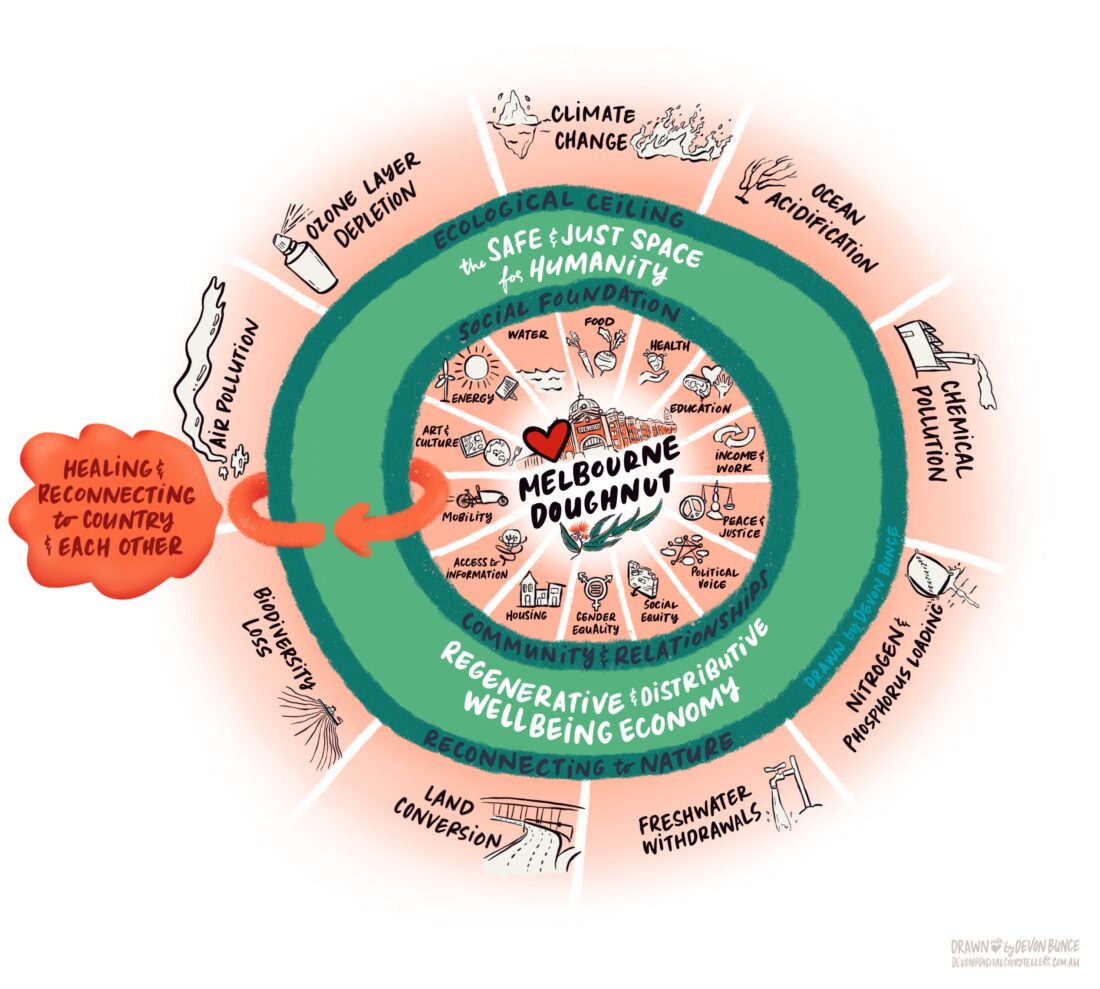Story-powered systems change – using story to imagine a more regenerative economy
How an economist, a group of changemakers and a doughnut are using the power of story to help cities reimagine a bold and regenerative new global economy that is a (w)hole lot better for all.
No more sugar coating – our systems need changing
We are grappling with a series of cascading global economic, social and environmental crises right now, which are dramatically exposing how fragile and inequitable many of our current systems truly are. However, as painful as the crumbling of long-held narratives can be, the prospect of change can also be wildly exciting.
So, with the help of an economist and a doughnut, it’s time to start using the power of story to reimagine our global systems and get to work creating a bold and beautiful new narrative for the world.

Doughnut economics 1🍩1
One person who has taken up the challenge of reimagining a more just and inclusive world, starting with a global economy that supports both people and planet to flourish, is Kate Raworth. Passionate about making economics fit for the realities and complexities of the 21st century, Raworth created a model of a thriving and well balanced economy, that looks a hole lot like – well, a doughnut (#notsorry).
In her 2017 book titled ‘Doughnut Economics: Seven Ways to Think Like a 21st Century Economist’, Raworth presented seven ways to rethink our global economic systems. Visualised as two concentric circles, Doughnut Economic theory places our social foundation as the inner ring and ecological boundaries as the outer ring. The sweet, sweet goal is to live within the doughnut (salivating yet? 🤤), and no longer trying to force an economy to grow at all costs.
“The doughnut has been adapted in many different places and contexts, each with their own picture of how doughnut economics looks in their community, their place. It’s a visual that brings together hours of conversations and workshops, many different voices and perspectives. An array of views reflecting on and dreaming about their own system and its future, and how that fits into the bigger picture of the whole.” – Devon Bunce, Story Scribe and Illustrator
Double-glazed for everyone
Applying Raworth’s concept, in recent years, cities around the world such as Amsterdam, Philadelphia and Portland have begun to localise the ‘doughnut model’ and dunk into it for their city (#alittlesorry).
Formed at the height of the COVID-19 pandemic in 2020, the movement made its way Down Under with more than 500 individuals and 40 organisations from across sectors and disciplines coming together as part of Regen Melbourne.
Using storytelling as a driving mechanism, Regen Melbourne embarked on a community engagement process designed to build trust, connection, alignment, and gather data, through participatory workshops, leadership interviews and roundtables, culminating in an initial report titled: ‘Towards a Regenerative Melbourne’.
“The strategy for Regen Melbourne is to use the doughnut as a catalysing and mobilising tool to help us create a more regenerative city and regenerative world.” – Willow Berzin, Convenor Regen Melbourne and Coalition of Everyone
One thing that Regen Melbourne recognised from the outset is that storytelling was the perfect tool to help get the ‘doughnut’ rolling (last one, we promise 😉) for a post-COVID Melbourne and regenerative economy for all. That is because story is fundamental to systems change.
Storytelling for systems change
In many ways, our best hope of rising to the challenges before us is by taking a ‘systems approach’. To do this, we must be able to find ways of seeing and piecing together seemingly disparate parts of the puzzle to create a wide view of the ‘system’, how it functions and what needs to change. This is where story comes in.
As Ella Saltmarshe writes, stories: ‘make, prop up, and bring down systems. Stories shape how we understand the world, our place in it, and our ability to change it.’ And there are three vital elements of story craft that can help us enact systems change – Storytelling, Story Listening and Story Leadership. Let’s break them down:
-
Storytelling → reveals the existing narrative and helps to form a new one
What makes storytelling so powerful in systems change is that it goes to the core of what needs shifting: the narrative – i.e. the collectively held ideas about the way things ‘are’.
Systems change often involves shifting away from how things are, and instead painting a compelling and captivating alternative of how things can be. Stories are perfectly fit for this purpose – simultaneously helping to crystallise a shared vision, spark imaginations and influence actions.
You can use storytelling to provide a bridge between ‘the problem’ and ‘the solution’, between the past/present and the future, and help light a path to get there. Whether it’s verbal or visual or both, helping people tell their story is a critical part of any meaningful and collaborative community engagement process, and something the Regen Melbourne crew baked in from the start (ok, that really was the last one 🙈).
-
Story Listening → allows for diverse voices and multiple perspectives, and the building of connection, trust, and empathy
Stories create space for plurality in a way few other mediums can. As the ‘lead storyteller’ of Regeneration Projects’ Voices of Regen, Jaari Heyes has listened to the stories of farmers, entrepreneurs, activists, conservationists, community leaders, and visionaries, all part of the Regen movement. She shares the one thing they all have in common is that they are pioneers of regenerative business and living, but they have each done it in their own way. There’s no ‘one size fits all’ when it comes to story.
Through the process of Story Listening, we bridge divides, build connections, and bind communities together. The beauty of using story to drive systems change in this way is that it is scalable, inclusive and it is proven to work.
-
Story Leadership → the ability to create and hold the space from which a new collective narrative can emerge
Throughout their workshops, interviews and roundtables, Regen Melbourne not only used story to make the concept of doughnut economics more accessible, but they created and held space for participants to consider their vision for a thriving Melbourne. What surfaced was dozens and dozens of vision statements that needed to be synthesised and shared.
With the help of one of our talented story scribes, Devon, Regen Melbourne led a memorable and shareable story illustration process and created a unified vision for the movement.

“The gift of using visual storytelling in communicating complex systems change is the ability to convey your unique perspective into the greater system. To better understand the system, we need to explore its parts, its interconnections and flows of energy. Creating a visual helps reflect the system back to itself, and from that place, the conversation can continue to refine, reflect and expand. There’s often something that happens to ideas when people see them drawn out. My hope is that these illustrations offer both more clarity, and a semblance of common ground from which to expand. It’s a ‘story artefact’ of a conversation that can live and develop into the future.” – Devon Bunce, Story Scribe & Illustrator
It is this ability to synthesise vast and varied amounts of information that makes storytelling such a powerful part of sense-making and systems thinking. Story illustrations like this make movements and ideas more accessible; to be grasped at a glance. By making big, complex systems-change like this easier to conceptualise and communicate, story makes change more likely and the prospect of reimagining a new way of doing things less daunting.
Growing the regenerative movement in Australia
Using story as a driver, Regen Melbourne has not only created a blueprint for how to localise doughnut economic concepts in Australia, but they have managed to (re)generate a buzz and excitement that is growing the movement rapidly. Now it’s time to invite more people to be part of the conversation and turn this radical idea into transformative action.
“[We are thinking] ‘how we can help build this movement’ and invite more people in to connect with others, ‘how do we lift up people who have been left behind and marginalised’? There’s a whole lot of people whose voices haven’t been included yet. And so the next stages will be figuring out how to actually reach and speak to and listen to other voices to better understand the diversity of Melbourne’s communities, which makes us stronger.” – Willow Berzin, Convenor Regen Melbourne
For those curious changemakers in Greater Sydney, Regen Sydney organisers are planning an event in Spring 2021 to build connections, gain greater visibility of work currently underway across the city, and imagine a regenerative future for Sydney – thriving inside the Doughnut. To stay in the loop, register your interest with Regen Sydney.
Right now, we are being called to look near and far to reimagine new (or perhaps ancient) ways of doing things, of seeing the world, and of responding to the challenges before us. The central question that we need to be asking ourselves is: do we want to tell a story of individualism, chaos and fear? Or can we find a way to step into a story of community, trust and regeneration?
We love telling stories of systems change and the challenge of sharing complex work with the world. If you are curious about how to grow your movement using story, get in touch about a digital illustration or story listening workshop for your network or movement and get ready to share your vision for a bold and beautiful new world.

